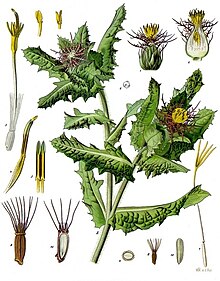Centaurea benedicta
This article needs additional citations for verification. (May 2010) |
| Centaurea benedicta | |
|---|---|

| |
| Scientific classification | |
| Kingdom: | Plantae |
| Clade: | Tracheophytes |
| Clade: | Angiosperms |
| Clade: | Eudicots |
| Clade: | Asterids |
| Order: | Asterales |
| Family: | Asteraceae |
| Tribe: | Cardueae |
| Subtribe: | Centaureinae |
| Genus: | Centaurea |
| Species: | C. benedicta
|
| Binomial name | |
| Centaurea benedicta (L.) L.
| |
| Synonyms[1] | |
|
List
| |
Centaurea benedicta, known by the common names St. Benedict's thistle, blessed thistle, holy thistle and spotted thistle, is a thistle-like plant in the family Asteraceae, native to the Mediterranean region, from Portugal north to southern France and east to Iran. It is known in other parts of the world, including parts of North America, as an introduced species and often a noxious weed.
Growth
Centaurea benedicta is an annual plant growing to 60 cm tall, with leathery, hairy leaves up to 30 cm long and 8 cm broad, with small spines on the margins. The flowers are yellow, produced in a dense flowerhead (capitulum) 3–4 cm diameter, surrounded by numerous spiny basal bracts. Blessed thistle blooms mid summer to early fall.
All parts of the plant have a light down covering. This plant has a sprawling habit instead of standing upright. It needs full sun to grow and good soil drainage, as it will die in waterlogged soil. Water blessed thistle daily if you want your plant to produce lush leaves.
Seeds are too large to start in most seed trays, so it is recommended to sow outside after the danger of frost passes.[2] Bury the seed 1/4 inch in the soil which should remain most until germination that takes between two and three weeks. Leave at least 12 to 15 inches of space between plants.
In literature
In Shakespeare's comedy Much Ado About Nothing, “Carduus Benedictus”, in tincture form, is recommended for a cold.[3] The pointed allusion, by Margaret, is to Beatrice's tormentor-lover, Benedick.
Edibility and medicinal use
These thistles are not considered edible, unlike Cirsium, Arctium and Onopordum species; the leaves are considered unpalatable if not bitter.
Blessed thistle is mostly used for medicinal purposes. Cnicin, the main component in this herb, is considered to have antibacterial properties, and to be anti-cancer and anti-inflammatory. This plant was used to treat the Black Plague during the Middle Ages.[4] Now it is mostly used as a galactagogue with other herbs to increase breast milk supply.[5] It is also used to aid the digestive system and detoxify the liver just like milk thistle.
Blessed thistle can help neutralize bacteria such as E. Coli, Staphylococcus aureus, and Bacillus subtilis. Cnicin blocks the enzymes necessary for bacteria replication so they are not able to reproduce and die.[6]

References
- ^ "The Plant List".
- ^ "Grow Blessed Thistle for its Beautiful Yellow and Red Flower Crown of Thorns - Herba Medicine". 19 February 2020. Retrieved 2021-11-21.
- ^ Phillips, Roger (1990). The Random House Book of Herbs. Random House. pp. 173. ISBN 9780679732136. Retrieved 1 September 2019.
Much Ado About Nothing.
- ^ "Health Benefits of Blessed Thistle can Cure it All, Even the Plague!". Herba Medicine. 2021-11-13. Retrieved 2022-05-21.
- ^ "Blessed Thistle", Drugs and Lactation Database (LactMed), Bethesda (MD): National Library of Medicine (US), 2006, PMID 30000834, retrieved 2022-05-21
- ^ Steinbach, Anke; Scheidig, Axel J.; Klein, Christian D. (2008-08-01). "The Unusual Binding Mode of Cnicin to the Antibacterial Target Enzyme MurA Revealed by X-ray Crystallography". Journal of Medicinal Chemistry. 51 (16): 5143–5147. doi:10.1021/jm800609p. ISSN 0022-2623. PMID 18672863.
External links
- Cnicus Benedictus.—Blessed Thistle
- Spotted thistle entry in the public domain NCI Dictionary of Cancer Terms
- Articles with short description
- Short description matches Wikidata
- Articles needing additional references from May 2010
- All articles needing additional references
- Articles with 'species' microformats
- Commons link is locally defined
- Taxonbars with automatically added basionyms
- Taxonbars with 25–29 taxon IDs
- Taxonbars with 30–34 taxon IDs
- Cardueae
- Galactagogues
- Medicinal plants of Asia
- Medicinal plants of Europe
- Monotypic Asteraceae genera
- Plants described in 1753